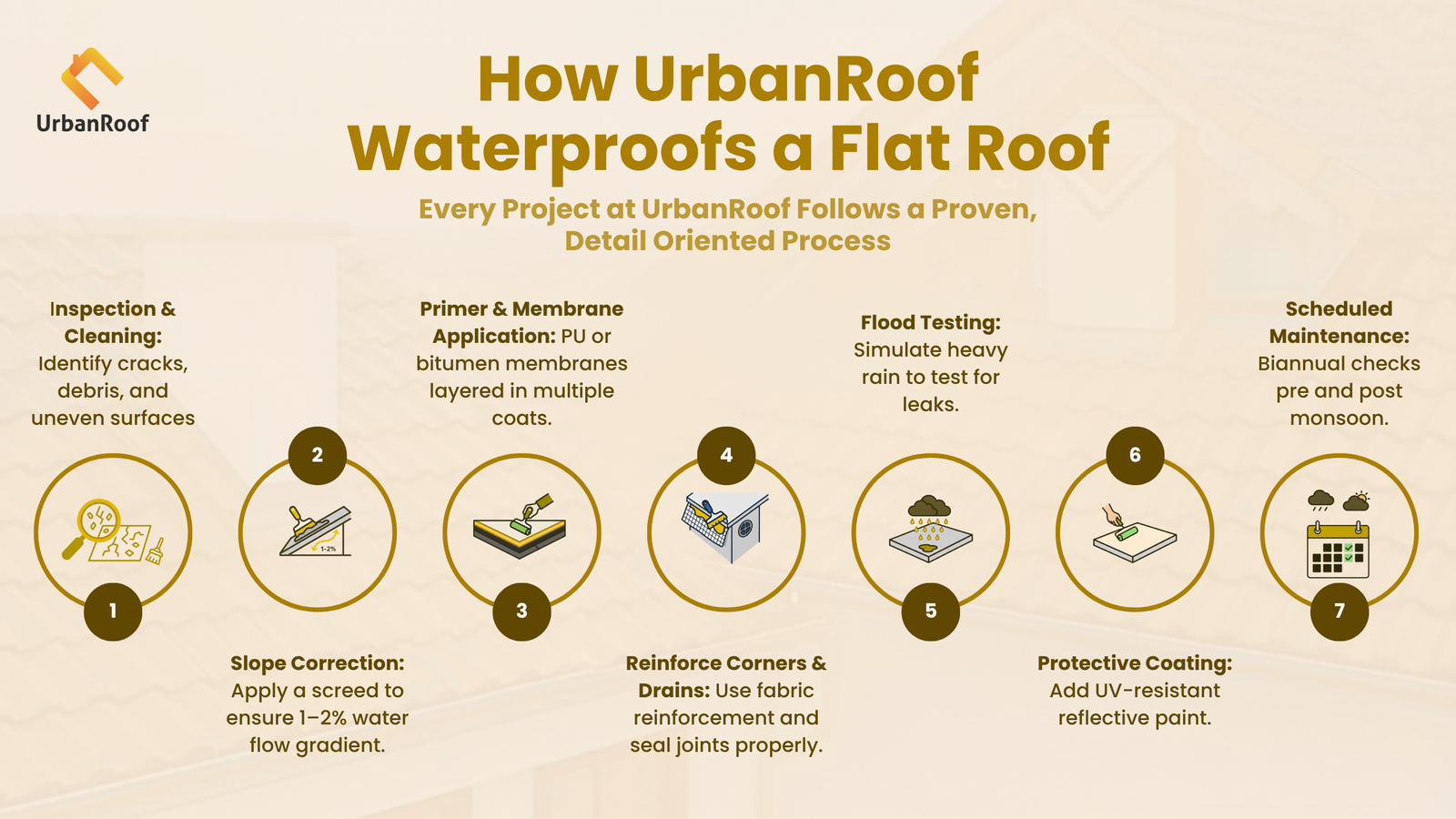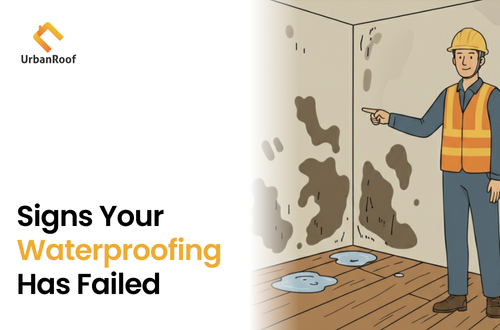Flat Roof vs Sloped Roof: Which Roof Is Easier to Waterproof?
Your roof doesn’t just protect you from rain — it safeguards your entire home. Whether it’s a family residence or a rental property, the real test begins when the monsoon arrives. That’s when many homeowners learn the value of proper waterproofing.
At UrbanRoof, after inspecting thousands of Indian homes, we’ve seen both flat and sloped roofs perform well — and fail — depending on how they’re designed and waterproofed. In this guide, we answer the big question clearly: which roof is easier to waterproof, and what practical steps you can take to keep your roof leak-free.
Why Waterproofing Is the Heart of Every Healthy Roof
Waterproofing isn’t a finishing touch — it’s the foundation of a durable roof. Without it, even the best concrete or tiles can let rainwater penetrate, causing cracks, ceiling stains, and corrosion. In India’s long monsoon seasons, proper waterproofing prevents early deterioration and protects your home’s structural elements.
UrbanRoof inspections show most leaks originate from minor design flaws like poor drainage or uneven surfaces — not from obvious cracks. In short: a roof designed and treated correctly can last far longer. This is the reason flat roof vs sloped roof waterproofing decisions matter.
Flat Roof Waterproofing: Great for Space, Demanding for Care
Flat roofs are hugely popular in Indian cities because they provide usable terrace space for water tanks, solar panels, rooftop gardens, and more. But this utility comes with a key challenge: water doesn’t drain naturally.
1. The Problem with Ponding
Even a small design flaw or a clogged outlet can cause ponding. Standing water degrades waterproof layers, causes microcracks, and accelerates seepage. That’s why flat roof vs sloped roof waterproofing often favors careful slope design and drainage for flat terraces.
2. Weather & Heat Stress
Flat roofs take the full brunt of India’s sun. Repeated thermal expansion and contraction can damage membranes, especially near parapets and joints. Choosing flexible, UV-resistant systems is crucial for longevity.
3. The Maintenance Advantage
The upside is accessibility: flat roofs are easier to inspect and repair. Regular checks and timely maintenance will keep a flat roof performing as well as a sloped roof — provided you use the right materials and ensure proper drainage.
UrbanRoof tip: For flat roofs, PU (polyurethane) coatings or bituminous membranes perform well in India — they resist UV and adapt to thermal movement.
Sloped Roof Waterproofing: Designed for Drainage
Sloped (pitched) roofs are naturally better at shedding water and are common in hilly and high-rainfall regions. Their gradient is a powerful advantage for waterproofing.
1. Natural Drainage Advantage
With a slope, gravity does most of the work: rainwater flows off quickly, reducing the risk of ponding and prolonged wetness. This simple physics makes flat roof vs sloped roof waterproofing often lean in favor of sloped designs for low-maintenance performance.
2. Less Exposure, Longer Life
The waterproof layer beneath tiles or shingles dries faster and stays less saturated. This extends its life and reduces maintenance frequency compared to poorly drained flat roofs.
3. Areas That Need Extra Care
Weak spots on sloped roofs include valleys, ridgelines, and flashings. If these details aren’t sealed correctly, water can infiltrate rapidly. Good installation of metal or polymer flashings and proper overlap of tiles is essential.
UrbanRoof tip: Use high-quality flashings and ensure tile overlaps are correct at valleys and junctions to prevent leaks.
Flat vs Sloped: Side-by-Side Comparison
| Factor | Flat Roof | Sloped Roof |
|---|---|---|
| Drainage | Needs engineered slope & outlets | Naturally efficient |
| Maintenance | Easier to access & repair | Harder to access |
| Leak Risk | Higher due to ponding | Lower due to runoff |
| Lifespan (with care) | 10–15 years | 20–30 years |
| Waterproofing Cost (₹/sq ft) | ₹40 – ₹120 | ₹25 – ₹80 |
Verdict: Sloped roofs are naturally easier to waterproof because they drain better. However, a well-designed flat roof with professional waterproofing and good drainage can perform equally well and provide valuable usable terrace space.
How UrbanRoof Waterproofs a Flat Roof (Step-by-Step)
- Inspection & Cleaning: Identify cracks, debris, and uneven surfaces.
- Slope Correction: Apply screed to ensure a 1–2% gradient for drainage.
- Primer & Membrane Application: Multiple coats of acrylic/PU/bitumen as required.
- Reinforce Corners & Drains: Use fabric reinforcement and seal joints with flexible sealants.
- Flood Testing: Simulate heavy rain to check for leaks.
- Protective Coating: Apply UV-resistant reflective paint to reduce heat and UV damage.
- Scheduled Maintenance: Pre- and post-monsoon checks to ensure continued performance.
UrbanRoof tip: Poorly designed drainage outlets cause up to 80% of flat roof leaks. Keep outlets unclogged and ensure correct placement during design.
Waterproofing Solutions for the Indian Climate
Indian roofs face heat, heavy rain, and humidity. Here’s what works best:
- Flat Roofs: PU or elastomeric coatings and bituminous membranes. Avoid brittle cementitious mixes that crack with thermal movement.
- Sloped Roofs: High-quality flashings, breathable underlayment, and correct tile/shingle overlaps.
- All Roofs: Reflective coatings can reduce roof surface temperature by up to 10°C, improving comfort and protecting membranes.
- Maintenance: Inspect roofs every 6 months, especially before monsoon season.
UrbanRoof insight: Most leaks we fix began months earlier due to unnoticed microcracks or blocked drainage. Prevention always costs less than repair.
Final Thoughts
If your priority is low maintenance and long life, a sloped roof generally wins for easier waterproofing. If you value modern design and terrace usability, a flat roof is an excellent choice — as long as you invest in quality waterproofing and routine upkeep.
At UrbanRoof, we combine expert inspections, advanced materials, and precise application techniques to ensure roofs stay dry, safe, and low-maintenance year-round. Whether you’re choosing between flat roof vs sloped roof waterproofing or need a retrofit solution, our team delivers durable results tailored to Indian conditions.
Book an Inspection with UrbanRoof
Don’t wait for leaks to appear. Book a professional inspection today to get an engineer-led assessment, detailed report, and a custom waterproofing plan that protects your home before the next monsoon.
Frequently Asked Questions
Flat Roof vs Sloped Roof Waterproofing
Is a flat roof harder to waterproof?
Yes — mainly because drainage is more challenging. But with modern PU membranes and proper slope design, flat roofs can be highly durable.
What’s the best waterproofing system for Indian homes?
PU coatings and bituminous membranes are top choices due to flexibility and weather resistance. Choice depends on roof type and exposure.
How often should waterproofing be redone?
Can UrbanRoof waterproof old roofs?
Yes. Our retrofit waterproofing seals leaks and restores performance without dismantling the roof in most cases.
How much does waterproofing cost?
Costs usually range from ₹25–₹120 per sq. ft., depending on system type and roof condition. UrbanRoof offers a free inspection to provide an accurate estimate.




